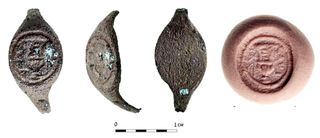This Ring Bears the Name of the Man Who Condemned Jesus to Death. Who Really Wore It?

A copper finger ring, dating back around 2,000 years, with an incised Greek inscription saying "of Pilatus" has been unearthed in the West Bank.
The discovery of the ring has led to speculation that it may have belonged to Pontius Pilatus (also called Pontius Pilate), the Roman prefect of Judea between A.D. 26 and 36 who, according to the Bible, ordered the crucifixion of Jesus. However, a team of researchers who analyzed the ring say that it likely belonged to someone else and not to the infamous Roman prefect.
The ring was found in 1968-1969 during excavations conducted at Herodium, a palace built for King Herod (who lived from 74 to 4 B.C), which is located about 3.1 miles (5 kilometers) southeast of Bethlehem in the West Bank. Herod was a king of Judea whose reign was supported by Rome. [Biblical Battles: 12 Ancient Battles Lifted from the Bible]
At the time the ring was discovered, archaeologists couldn't tell that it had an inscription on it. It wasn't until they used a technique known as reflectance transformation imaging photography (RTI) that the inscription was revealed and could be read. RTI is a technique that photographs an object multiple times with a light source from different angles. These photographs are then analyzed using computer software.
The design of the ring and its archaeological context mean that it could have been created anytime between the first century B.C. and the mid-first century A.D., the research team reported in an article published a few days ago in the Israel Exploration Journal.
Researchers believe that it was used as a sealing ring, a type of ring worn on a finger that can be pressed into soft material — like wax or clay — to create a seal that can be affixed to a document or object. Rings like these were often used in the ancient world.
Who might have worn it?
The name "Pilatus" is a rare name in the Roman world and past archaeological research has shown that part of the Herodium was in use during the time that Pilatus was prefect of Judea, the researchers wrote. . For these reasons, the researchers cannot completely reject the possibility that the ring was used by the prefect. However, it is unlikely, they wrote.
Sign up for the Live Science daily newsletter now
Get the world’s most fascinating discoveries delivered straight to your inbox.
One problem is that someone as high ranking as a prefect would likely have worn a much more elaborate ring, one made or gold or silver, with an incised gemstone, rather than a simple metal ring, the researchers wrote. In fact, the "thin, simple all-metal rings like the Herodium ring were primarily the property of soldiers, Herodian and Roman officials, and middle-income folk of all trades and occupations" and not of people of high status, such as a Roman prefect, the researchers wrote.
Another problem is that, aside from the inscription, the ring bears an image of a handleless krater, a type of vessel used for mixing water and wine. Kraters were often used in Jewish art around 2,000 years ago and would be an unusual choice for a Roman prefect, who was not Jewish,, the researchers wrote.
"We think it implausible that a prefect would have used a simple, all-metal, copper alloy personal sealing ring with a motif that was already a well-known Jewish motif in Judea before and during [Pontius Pilatus] rule," the researchers wrote in the article.
Although the person who wore this ring was likely not Pontius Pilatus, it's possible that whomever wore it had a connection to the Roman prefect and decided to use his last name. This could be someone in the administration of Pilatus, a freed slave of Pilatus or someone who was part of the family of Pilatus, the researchers wrote. It is also possible, however, that the person who wore the ring had no connection whatsoever to the famous Roman prefect and simply had the same last name.
The ring was found by Gideon Foerster, who is now an archaeology professor at Hebrew University of Jerusalem. The team members who analyzed the ring included Shua Amorai-Stark, an emeritus professor of art & aesthetics at Kaye College of Education at Beer Sheva, as well as Malka Hershkovitz, Yakov Kalman, Rachel Chachy-Laureys and Roi Porat, who are all affiliated with the Hebrew University of Jerusalem. Leah Di Segni, an archaeology professor at the Hebrew University of Jerusalem, analyzed the ring's inscription.
- Proof of Jesus Christ? 7 Pieces of Evidence Debated
- Religious Mysteries: 8 Alleged Relics of Jesus Christ
- The Holy Land: 7 Amazing Archaeological Finds
Originally published on Live Science.

Owen Jarus is a regular contributor to Live Science who writes about archaeology and humans' past. He has also written for The Independent (UK), The Canadian Press (CP) and The Associated Press (AP), among others. Owen has a bachelor of arts degree from the University of Toronto and a journalism degree from Ryerson University.
